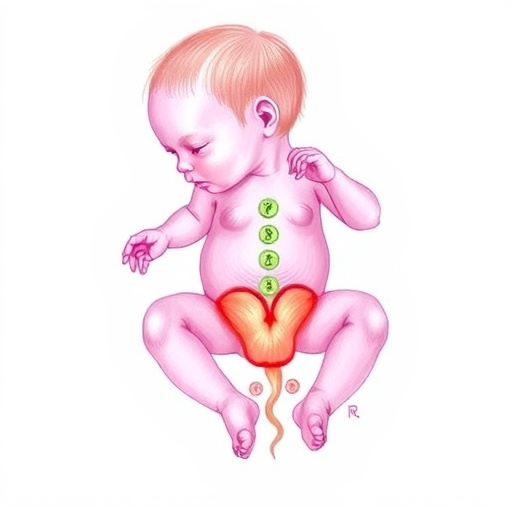Hypospadias is a congenital condition that has long captured the attention of medical researchers due to its complex interplay of genetic factors and developmental mechanisms. Recent findings from a study led by Ajayi, Oyowvi, and Akanbi delve deep into the genetic susceptibility and pathogenesis of hypospadias, unveiling insights that may pivot the future of preventive cultural practices and therapeutic approaches. The study, published in “Biochemical Genetics,” stands as a notable contribution to our understanding of this fascinating anomaly.
The prevalence of hypospadias, characterized by an abnormal location of the urethra in males, has increased in recent decades. This condition can lead to various physical complications, including difficulties with urination, increased risk of urinary tract infections, and issues related to sexual function. Investigating the genetic underpinnings of hypospadias is crucial, as it can yield pathways for earlier detection and more individualized treatment plans, ultimately improving quality of life for affected individuals.
In their comprehensive study, Ajayi and colleagues primarily focused on the hereditary aspects of hypospadias. They emphasized that genetic predisposition plays a significant role in the condition’s manifestation, suggesting that certain familial patterns could increase the likelihood of hypospadias in subsequent generations. This assertion opens up a profound dialogue about the importance of genetic counseling for families affected by this anomaly.
The researchers conducted extensive genomic analyses, mapping specific gene variants associated with hypospadias development. They performed whole-exome sequencing on affected individuals and their families, identifying several candidate genes that exhibited significant associations with the condition. Among these genes are those linked to key developmental pathways involved in male genitalia formation, further establishing the critical connection between genetics and anatomical integrity.
Moreover, Ajayi and his team explored epigenetic factors that may contribute to hypospadias. They noted that environmental influences, such as maternal exposure to endocrine-disrupting chemicals during pregnancy, could alter gene expression in ways that interfere with male fetal development. This aspect of their research highlights the race between genetic predisposition and environmental trigger, painting a more intricate picture of how congenital conditions may arise.
The investigation extended to assessing the role of maternal health and lifestyle factors in the development of hypospadias. The data revealed correlations between factors like maternal obesity, smoking, and advanced paternal age with an elevated risk of hypospadias. Such findings suggest that preventive measures that target maternal behavior and health could reduce incidence rates significantly, urging public health campaigns to prioritize education surrounding prenatal care.
Furthermore, the team illuminated the potential role of hormones in hypospadias pathogenesis. They posited that improper hormonal signaling during critical periods of fetal development, specifically androgen signaling, might skew normal urethral tube formation. Disruptions in androgen production or receptor response may lead to improper genital development that culminates in hypospadias.
As the research unfolded, the implications for clinical practice became palpable. The revelation that genetic and environmental interactions are at play offers a framework for developing diagnostic tools centered on genetic screening. Such advancements can help identify babies at risk for hypospadias earlier, presenting the opportunity for closer monitoring and hopefully earlier interventions to mitigate complications.
The approach taken by Ajayi et al. underscores the necessity of interdisciplinary collaboration in tackling congenital anomalies. By involving geneticists, pediatric urologists, and public health experts, the multifactorial nature of hypospadias can be addressed from various perspectives. Such collaboration could spur innovation in treatment modalities and preventive measures that may significantly alter how this condition is managed in clinical settings.
However, the quest for understanding hypospadias is far from complete. The researchers acknowledged that while their study has provided vital insights, many questions remain unanswered. For instance, the exact mechanisms by which identified gene variants contribute to hypospadias still require extensive investigation. Further studies will be critical in illuminating the causal relationships and mechanisms that underlie this complex condition.
As the understanding of genotypic and phenotypic variations in hypospadias evolves, there lies a significant ethical dimension to consider. Genetic screening and testing present dilemmas regarding potential stigma and the psychosocial burden on families. The findings of this study prompt healthcare providers to approach genetic counseling with sensitivity, ensuring that families understand the implications of genetic information without introducing undue anxiety.
This pioneering research from Ajayi and his colleagues not only advances the field of genetics but also fosters hope for the millions affected by hypospadias. It illustrates the need for a closer examination of how we can integrate genetic insights into clinical practice to better serve patients. As the scientific community continues to sift through the complexities of congenital disorders, it is clear that the intersection of genetics and environmental factors will remain essential to unlocking the mysteries of hypospadias.
The future of treatment and research stemming from this work holds promise for significant strides forward. With continued focus and innovation, the health outcomes for individuals with hypospadias can improve dramatically, contributing to the overarching goal of eradicating preventable congenital conditions. In so doing, the legacy of Ajayi and his team’s work can serve as a beacon for future research efforts aimed at improving the lives of countless individuals across the globe.
In summary, the study conducted by Ajayi, Oyowvi, and Akanbi sheds light on the intricate fabric of genetics and environmental interaction that contributes to hypospadias. Their research not only enriches our understanding of the condition but also lays the groundwork for novel preventive measures and therapies that could change many lives for the better. By investigating both genetic and environmental components, they provide a robust foundation for subsequent investigations and potential clinical applications that are crucial for managing this condition in the future.
Subject of Research: Genetic Susceptibility and Pathogenesis of Hypospadias
Article Title: Genetic Susceptibility and Pathogenesis of Hypospadias
Article References:
Ajayi, A.F., Oyowvi, M.O., Akanbi, G.B. et al. Genetic Susceptibility and Pathogenesis of Hypospadias.
Biochem Genet (2025). https://doi.org/10.1007/s10528-025-11199-9
Image Credits: AI Generated
DOI: 10.1007/s10528-025-11199-9
Keywords: Hypospadias, genetic susceptibility, pathogenesis, congenital condition, prenatal health, environmental factors, androgen signaling, genetic counseling, public health.




